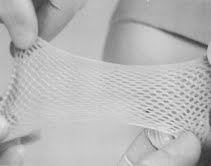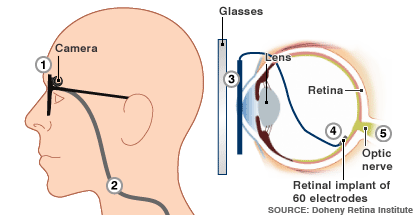Synthetic Skin
When people are asked what they know about synthetic organs, they immediately think of an artificial heart or kidney, but seldom do they think or mention artificial skin. The skin is the largest organ in the human body, and is composed of two layers called epidermis (outer) and dermis (inner). The skin is important because it serves a variety of functions such as keeping harmful bacteria out, protection from solar radiation, and thermoregulation. More importantly most people are not aware that artificial skin is currently the only FDA approved synthetic organ. (Medical Discoveries, 9) The first synthetic skin sheet was produced in the 1970 by scientists John F. Burke and Loannis V. Yannas, which constructed a bilayer artificial skin where the epidermis was made of Silastic, a silicon elastic polymer, and a porous dermis made from collagen-condroting-6-sulfate fibers. Since then similar techniques have been used to produce different kinds of synthetic skin sheeting, which can be used to help burn patients, surgical repair, scar healing, and research. Companies such as Bio-plexus, produces medical grade silicone sheeting, which can be used by doctors for emergency injuries, perforated eardrum repair, fractured orbital floors, etc. This product has good bio-compatibility, and is available with two degrees of firmness and a wide variety of thicknesses. (Bioplexus: Sheeting Page, 10) Other biotech companies such as Organogenosis Inc. are currently developing a bi-layered bio-engineered skin called, VCT101TM, in which the dermis is generated from human dermal fibroblasts and the epidermis is made by seeding human keratinocytes on top of the dermal matrix. (Medical Discoveries, 9) (Organogenesis Inc., 11) Synthetic Eye
Synthetic Eye
It is estimated that about 161 million in the world are blind, and 21.2 million people in the United States, as a result of an inherited disease, accident, etc. What can science and medicine do for these people? (Numberof.net, 12) Companies such as Bioceramics Limited located in India, have come up with a cosmetic solution to people who have damaged their eyeballs as a result of injury or disease. The product is called ceraEye and is made of synthetic hydroxyapaptite, which is biocompatible and bioactive. The implant allows good motility, and has a porous structure allowing vascularisation, which means that within six months of surgery tissues and blood vessels can encompass the orbital implant. Though this a good product, it lacks functionality as the person who receives the implant it is still not able to see. (Second Sight, 13) Fortunately biotechnology has developed a bionic eye system, that could help thousands of blind people to recover their sight. Though the FDA has only approved, trials in Europe, companies such as Second Sight, are currently working on having this new technology approved and available to the public. The device works by implanting a camera in a pair of glasses, a transmitter in the glasses sends a transmitter to the chip which is implanted in the back of the eye, electrodes in the chip are then able to send image through the optic nerve directly to the brain.The first bionic system that was produces had 16 electrodes on the implant and is still going through clinical trials at UCLA. The experiment continued by implanting the retinal chip in six people, all who of whom were able to recover some degree of sight. After a while they were able to perceive shapes, detect movement, etc. The bionic eye system being developed by Second Sight Inc. contains 60 electrodes and offers greater image resolution. Clinical trials in the U.S await approval of the FDA, but once this happens this new technology opens the way for people who have been blind for years to be able to see once again. (Layton, 14)

Bionic Eye
1: Camera on glasses views image
2: Signals are sent to hand-held device
3: Processed information is sent back to glasses and transmitted without wires to receiver under surface of eye
4: Receiver sends information to electrodes in retinal implant
5: Electrodes stimulate retina to send information to brain
Synthetic Lung
One example of an artificial organ is the artificial lung. A new device is has been developed that can help patients in need of a lung transplant for any reason. A natural lung exchanges gases to make sure your body has enough oxygen. One medical team at the University of Michigan, led by Dr. Robert Bartlett, have developed the BioLung. This lung works with the hearts own pumping action to help manage the oxygen and blood flow throughout the body. The BioLung uses the heart rather than mechanics in order to pump blood, which allows the patient to stay active at home instead of being hooked up to a machine or always at the hospital. (Steenhuysen, 15) (Reference.com, 16)

Biolung in a computer generated human body